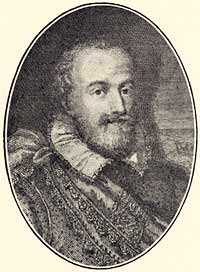Duke of Kingston-upon-Hull

Duke of Kingston-upon-Hull was a title in the Peerage of Great Britain, with the title Earl of Kingston-upon-Hull being a title in the Peerage of England. The Earldom was created on 25 July 1628 for Robert Pierrepont, 1st Viscount Newark. The Dukedom was created on 10 August 1715 for his great-grandson, Evelyn Pierrepont, 1st Marquess of Dorchester, who had succeeded as the fifth Earl of Kingston-upon-Hull in 1690. The Dukedom became extinct on the death of the second Duke in 1773. These titles are often informally shortened to the Duke (or Earl) of Kingston, and should not be confused with the separate Irish title, Earl of Kingston.
From the 13th century, the seat of the Pierrepont family had been Holme Pierrepont Hall, Nottinghamshire. This was to move during the sixteenth century to Thoresby Hall, also in Nottinghamshire. Several members of the family had served in the 15th and 16th centuries as High Sheriff of Nottinghamshire and Derbyshire.[1] The direct forebear of the Dukes and Earls of Kingson-upon-Hull was Sir Henry Pierrepont who represented Nottinghamshire in Parliament. He had married Frances Cavendish, daughter and eldest child of Sir William Cavendish and Bess of Hardwick.
Sir Henry Pierrepont's son, Sir Robert Pierrepont, was created Viscount Newark and Baron Pierrepont in the Peerage of England on 29 June 1627. In 1628 he was further honoured when he was made Earl of Kingston-upon-Hull with a remainder to heirs general, also in the Peerage of England. Robert Pierrepont had married Gertrude Talbot in 1601. She was a granddaughter of George Talbot, 6th Earl of Shrewsbury, and through him, all their descendents are able to claim descent from Edward III, through Edward's younger son, Thomas of Woodstock.
The first Earl was succeeded by his son, Henry Pierrepont, who was himself created Marquess of Dorchester in 1645. He died without heirs in 1660, and this Marquessate became extinct. The Earldom and other titles devolved on his nephew, Robert, the third Earl, the eldest son of the Honourable William Pierrepont, second son of the first Earl. Robert died unmarried and was succeeded by his younger brother, William, the fourth Earl. William was in his turn succeeded by his younger brother, the aforementioned Evelyn, the fifth Earl. He was created Marquess of Dorchester in the Peerage of England in 1706, a revival of the title held by his uncle, and later created Duke of Kingston-upon-Hull in the Peerage of Great Britain in 1715, with these titles becoming extinct on the death of the first Duke's grandson, Evelyn, the second Duke, in 1773. On the death of the second Duke's wife, the estates of the Dukes of Kingston-upon-Hull passed to Charles Medows. He was a great-grandson of the first Duke through the female line. He changed his surname to Pierrepont, and was created Baron Pierrepont, of Holme Pierrepont in 1796 and later created Earl Manvers in 1806. These titles became extinct on the death of the sixth Earl Manvers in 1955.
Several other members of the family have also gained distinction. The Honourable William Pierrepont, second son of the first Earl, was a politician. His third son Gervase Pierrepont was created Baron Pierrepont in 1701. Lady Mary Pierrepont, better known as Lady Mary Wortley Montagu, daughter of the first Duke, was a writer. Elizabeth Pierrepont, Duchess of Kingston-upon-Hull, wife of the second Duke, was a courtier.
Earls of Kingston-upon-Hull (1628)
- Other titles: Viscount Newark and Baron Pierrepont (1627)
- Robert Pierrepont, 1st Earl of Kingston-upon-Hull (1584–1643) was already Viscount Newark and Baron Pierrepont since 1627
- Henry Pierrepont, 2nd Earl of Kingston-upon-Hull (1607–1680) (created Marquess of Dorchester in 1645)
Marquesses of Dorchester; First creation (1645)
- Other titles: Earl of Kingston-upon-Hull (1628), Viscount Newark and Baron Pierrepont (1627)
- Henry Pierrepont, 1st Marquess of Dorchester (1607–1680), eldest son of the first Earl, died without issue, and his Marquessate became extinct
Earls of Kingston-upon-Hull (1628, Reverted)
- Other titles: Viscount Newark and Baron Pierrepont (1627)
- Robert Pierrepont, 3rd Earl of Kingston-upon-Hull (c. 1660–1682), eldest son of Robert Pierrepont (grandson of the first Earl), died without issue
- William Pierrepont, 4th Earl of Kingston-upon-Hull (c. 1662–1690), second son of Robert Pierrepont, died without issue
- Evelyn Pierrepont, 5th Earl of Kingston-upon-Hull (1665–1726) (created Marquess of Dorchester in 1706 and Duke of Kingston-upon-Hull in 1715)
Dukes of Kingston-upon-Hull (1715)
- Other titles: Marquess of Dorchester (1706), Earl of Kingston-upon-Hull (1628), Viscount Newark and Baron Pierrepont (1627)
- Evelyn Pierrepont, 1st Duke of Kingston-upon-Hull (1665–1726), third and youngest son of Robert Pierrepont
- William Pierrepont, Earl of Kingston (1692–1713), only son of the first Duke, predeceased his father
- Evelyn Pierrepont, 2nd Duke of Kingston-upon-Hull (1711–1773), only son of William, Lord Kingston. The second Duke died without issue and the Dukedom became extinct.
See also
References
- ↑ The History and Gazetteer of the County of Derby Vol 1 (1831) Stephen Glover. Appendix p 10 Edward IV. Google Books